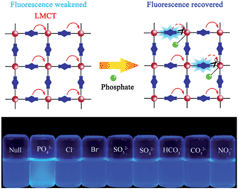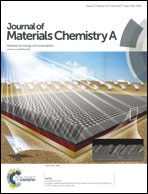Metal–organic frameworks with inherent recognition sites for selective phosphate sensing through their coordination-induced fluorescence enhancement effect†
Abstract
Luminescent metal–organic frameworks (LMOFs) have attracted significant attention as a unique class of sensing materials. In this work, the intrinsically fluorescent amino derivative of UiO-66 (UiO-66-NH2) was successfully exploited as a fluorescent probe for the sensitive and selective detection of phosphate anions in an aqueous medium. The inorganic Zr–O clusters and organic BDC-NH2 linkers in the elaborated UiO-66-NH2 MOFs were individually designed as phosphate recognition sites and signal reporters. The intrinsic fluorescence of BDC-NH2 was tuned from high to weak emission by ligand-to-metal charge transfer (LMCT) upon its integration into the framework of UiO-66-NH2 MOFs and this weakened fluorescence could be proportionally recovered in correlation with the applied phosphate level through a newly developed competitive coordination effect. The specificity for phosphate recognition of the employed sensory platform was scarcely affected by other possible interfering species. The efficacy of this strategy was demonstrated by a linear phosphate detection range of 5–150 μM and a limit of detection of 1.25 μM, which was far below the detection requirement of phosphate discharge criteria in the water environment. The possible sensing mechanisms for anionic phosphate detection using the currently established fluorescent probe, including host–guest interaction and structure–property correlation, were systematically investigated using XPS, FT-IR, XRD, TEM and N2 sorption techniques.


 Please wait while we load your content...
Please wait while we load your content...